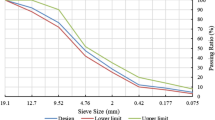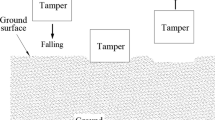Abstract
In this study, the discrete-element model (DEM) of asphalt pavement is established to discuss the effects of temperature changes of interlaminar bonding layer on mechanical responses of asphalt pavement in different seasons. Calculated and test results indicate that the temperature within the depth range of 0–5 cm in asphalt pavement is obviously affected by ambient temperature. The heat is accumulated within the pavement depth range of 2–5 cm, greatly affecting the interlaminar bonding state. In addition, lower temperature in winter increases the continuity of asphalt pavement layers, reducing the compressive stress in upper layer. In addition, higher temperature in summer weakens the interlaminar bond, increasing the horizontal tensile stress in upper layer and at the interlaminar interface. Further, lower interlaminar bonding strength increases the maximum shear stress at the interlaminar interfaces between asphalt pavement layers, as well as at the interface between asphalt mortar and aggregate. As the pavement depth is increased, the horizontal shear stress is increased. Finally, the high temperature increases the tensile strain near the bottom of upper layer. The displacement directions of more aggregate particles move vertically downward at low temperature, but move to two lateral sides at high temperature.
















Similar content being viewed by others
References
Wang, J., Xiao, F., & Chen, Z. (2017). Application of tack coat in pavement engineering. Construction and Building Materials, 152, 856–871
Wu, S. H., Chen, H. X., & Zhang, J. P. (2017). Effects of interlayer bonding conditions between semi-rigid base layer and asphalt layer on mechanical responses of asphalt pavement structure. International Journal of Pavement Research and Technology, 10(3), 274–281
Chen, T., Luan, Y., & Ma, T. (2020). Mechanical and microstructural characteristics of different interfaces in cold recycled mixture containing cement and asphalt emulsion. Journal of Cleaner Production, 258, 120674
B. Al Hakim. An improved backcalculation method to predict flexible pavement layers moduli and bonding condition between wearing course and base course. (Thesis (Ph.D.), Liverpool John Moores University, 1997). http://researchonline.ljmu.ac.Uk/id/eprint/5571.
Mariana, R. K., Andrew, C. C., & Nicholas, H. T. (2005). Effect of bond condition on flexible pavement performance. Journal of Transportation Engineering, 131(11), 880–888
Li, J., Guo, W., & Meng, A. (2020). Investigation on the micro deformation mechanism of asphalt mixtures under high temperatures based on a self-developed laboratory test. Materials, 13(7), 1791
Sabine, L., Gustavo, C. F., & Bettina, G. (2019). Mechanical testing and modeling of interlayer bonding in HMA pavements. Transportation Research Record, 2673(11), 879–890
Qian, G., Li, S., & Yu, H. (2019). Interlaminar bonding properties on cement concrete deck and phosphorous slag asphalt pavement. Materials, 12(9), 1427
Biglari, M., Asgharzadeh, S. M., & Tehrani, S. S. (2018). Evaluation of factors affecting tack coat bond strength. Canadian Journal of Civil Engineering, 46(4), 270–277
Hu, X. D., Lei, Y., & Wang, H. (2017). Effect of tack coat dosage and temperature on the interface shear properties of asphalt layers bonded with emulsified asphalt binders. Construction and Building Materials, 141, 86–93
Graziani, A., Canestrari, F., & Cardone, F. (2017). Time-temperature superposition principle for interlayer shear strength of bituminous pavements. Road Materials and Pavement Design, 18, 12–25
Li, L., Gao, Y., & Zhang, Y. (2020). Crack length based healing characterisation of bitumen at different levels of cracking damage. Journal of Cleaner Production, 258, 120709
Zhang, L., Huang, J., & Li, P. (2020). Prediction of temperature distribution for previous cement concrete pavement with asphalt overlay. Applied Sciences, 10(11), 3697
Chen, J., Wang, H., & Xie, P. (2019). Pavement temperature prediction: Theoretical models and critical affecting factors. Applied Thermal Engineering, 158, 113755
Si, W., & Ma, B. (2018). Temperature responses of asphalt mixture physical and finite element models constructed with phase change material. Construction and Building Materials, 178, 529–541
Chu, L., He, L., & Fwa, T. F. (2020). Determination of thermal conductivity of asphalt paving mixtures using finite element method. Construction and Building Materials, 243, 118250
Liu, D., Xia, X., & Sun, L. (2020). Movement and embedding characteristics of interlayer aggregates during roller-compacted concrete compaction process using discrete element simulation. Construction and Building Materials, 249, 118765
Huang, K., Xu, T., & Li, G. (2016). The feasibility of DEM to analyze the temperature field of asphalt mixture. Construction and Building Materials, 106, 592–599
Huang, K., Xu, T., & Li, G. (2016). Heating effects of asphalt pavement during hot in-place recycling using DEM. Construction and Building Materials, 115, 62–69
Peng, Y., Wan, L., & Sun, L. (2019). Three-dimensional discrete element modelling of influence factors of indirect tensile strength of asphalt mixtures. International Journal of Pavement Engineering, 20(6), 724–733
Wang, H., Behnia, B., Buttlar, W. G., & Reis, H. (2020). Development of two-dimensional micromechanical, viscoelastic, and heterogeneous-based models for the study of block cracking in asphalt pavements. Construction and Building Materials, 244, 118146
Gu, F., Ma, W., & West, R. C. (2019). Structural performance and sustainability assessment of cold central-plant and in-place recycled asphalt pavement: A case study. Journal of Cleaner Production, 208, 1513–1523
Ma, T., Zhang, D., & Zhang, Y. (2016). Microstructure modeling and virtual test of asphalt mixture based on three-dimensional discrete element method. Journal of Central South University, 23(6), 1525–1534
Guan, Y., & Guan, H. (2019). Algorithms for modelling 3D flexible pavements and simulation of vibration cutting by the DEM. International Journal of Pavement Engineering, 20(10), 1127–1139
Fakhri, M., Kheiry, P. T., & Mirghasemi, A. A. (2012). Modeling of the permanent deformation characteristics of SMA mixtures using discrete element method. Road Materials and Pavement, 13(1), 67–84
Yan, X., Chen, L., & You, Q. (2019). Experimental analysis of thermal conductivity of semi-rigid base asphalt pavement. Road Materials and Pavement, 20(5), 1215–1227
Peng, Y., Gao, H., & Lu, X. (2020). Micromechanical discrete element modeling of asphalt mixture shear fatigue performance. Journal of Materials in Civil Engineering, 32(7), 1943
Feng, H., Pettinari, M., & Hofko, B. (2015). Study of the internal mechanical response of an asphalt mixture by 3-D discrete element modeling. Construction and Building Materials, 77, 187–196
Zhang, Y., Ma, T., & Luo, X. (2019). Prediction of dynamic shear modulus of fine aggregate matrix using discrete element method and modified Hirsch model. Mechanics of Materials, 138, 103148
Ding, X., Ma, T., & Gu, L. (2020). Investigation of surface micro-crack growth behavior of asphalt mortar based on the designed innovative mesoscopic test. Materials and Design, 185, 108238
Cho, S., Lee, K., & Mahboub, K. (2019). Evaluation of fatigue cracking performance in a debonded asphalt pavement. International Journal of Pavement Research and Technology, 12(4), 388–395
Zhang, J., Tan, H., & Pei, J. (2019). Evaluating crack resistance of asphalt mixture based on essential fracture energy and fracture toughness. International Journal of Geomechanics, 19(4), 1390
Acknowledgements
This work was supported by National Natural Science Foundation of China (no. 51978340), Provincial Six Talent Peaks Project in Jiangsu (no. JNHB-050), and Jiangsu Provincial Department of Education for the Qing Lan Project. In addition, we would like to thank Advanced Analysis & Testing Center of Nanjing Forestry University for the assistance in experiments.
Author information
Authors and Affiliations
Corresponding author
Rights and permissions
About this article
Cite this article
Xu, J., Li, N. & Xu, T. Temperature Changes of Interlaminar Bonding Layer in Different Seasons and Effects on Mechanical Properties of Asphalt Pavement. Int. J. Pavement Res. Technol. 15, 589–605 (2022). https://doi.org/10.1007/s42947-021-00039-9
Received:
Revised:
Accepted:
Published:
Issue Date:
DOI: https://doi.org/10.1007/s42947-021-00039-9




